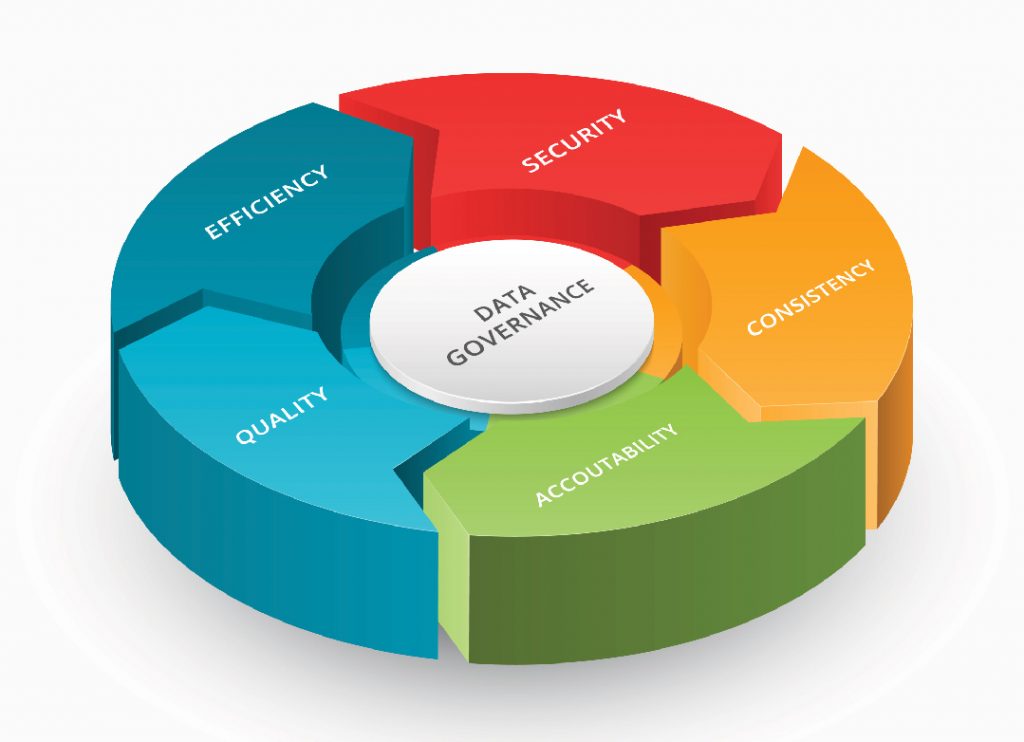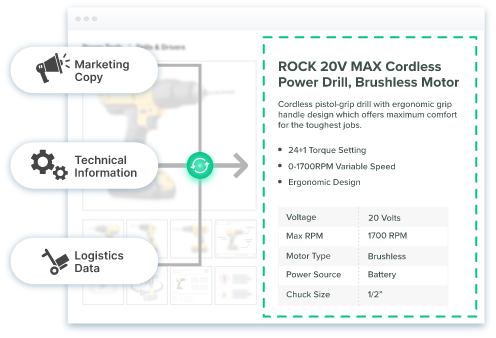Using data governance to help marketing departments drive conversions is a recent development.
Ironically, you can see this is true because statistics connecting data governance and eCommerce marketing are almost impossible to find. In any case, online sales still center around product pages. And those product pages bring together the following:
- Descriptions
- Specifications
- Features
- Images
- Videos
- CAD diagrams
It’s never been more important to understand how data governance connects to product content marketing to drive sales success.
For example, using software to maintain product information and digital asset quality and completeness, making rich product pages, is just one way it applies to product content management.
In this blog, we investigate how to deal with info and the emergence of data governance specifically in regard to product content.

What is Data Governance?
You can think of it as a set of core practices dealing with data discoverability, maintenance, and security.
Data governance is a practice best suited for mid-size, medium enterprise, and global enterprise operations. It plays a limited role in small and mid-sized businesses, because they typically place responsibility for master info management in the hands of only a few key individuals.
The History of Data Governance
In the heyday of client-server systems, recognizing the value of enterprise data became the innovation of the century.
Although nobody knows who coined the term ‘data governance,’ it came into use to help enterprises streamline processes for capturing, updating, and discovering. Security joined this party a little later, when the importance and value of information became more apparent.

Data Governance, Enforcement, and Product Data
Ensuring data quality sits at the center of the relationship between governance and product content. However, depending on the particular industry, needs can vary. As explained above, the focus should be on mid-size and enterprise brands, and as related to product info.
Within that context, the importance of implementing 5 key data governance principles becomes clear.
- Identify everyone who has to use info for discoverability, decision making, analytics, and maintenance.
- Determine access security levels.
- Entrust the work of updating content to the right stakeholders in the appropriate departments.
- Enforce the necessary quality checks, in the form of system validation, at the point of entry.
- Put into place the necessary review and approval steps to verify information.

Product Data Isn’t Enough
Data is essential, but it’s rarely enough from a product marketing standpoint.
Elevating digital assets to the same level of importance is an ever increasing need. Because eCommerce is a visual experience, images and videos are critical to driving conversions.
Governance is essential for a marketing department to succeed at convincing and converting prospects into customers with brand messaging. It isn’t enough to do this with ease, unless the product is very industrial or scientific in nature.
A majority of departments need it because they have to master not just data, but they also need digital assets. Product info is critical, for example:
- Categorization
- Product families
- Variations
- Specifications
- Packaging information
- Weights
- Units
This doesn’t diminish the need for rich content, but this isn’t enough.
Successful organizations are the ones that have put practices and systems in place to govern it and digital assets.
(Read everything you need to know about why product information and digital assets should be stored together in the blog featured below.)
Data Governance Evolution
Although it is a necessity and key ingredient for robust product pages, it isn’t enough to generate visual interest in the product. Hence a product with complete information is not enough for SEO, marketing, or conversion.
This has led leading brands to adopt similar governing principles when it comes to rich content like product images, different product views, certifications, applications, 360 images, spec sheets, pdf documents, and installation guides.

5 Ways Data Governance Drives Revenue
1. Product Experience
Accurate, up-to-date content along with rich digital assets and enhanced content, delight customers. The bedrock of a solid product page is rich, enhanced content.
The core strength of governance is improved decision making – with regard to PIM, this ability is passed to the customer. Once the customer is informed, they can decide to buy with confidence.
2. Time to Market
You can go live with your product quickly and with more rich content once you have a governance process in place. This speed facilitates better planning across teams, so that product launches are more robust.
If you are targeting a launch window, taking advantage of a trade show, writing press releases, or otherwise focused on marketing, data governance will improve outcomes. You’ll know your content and product pages will be in top shape.
(Read everything you need to know about optimizing your product pages in the blog featured below.)
3. Buyer Satisfaction
When you ensure customers know exactly what they are buying, you minimize disappointing them with products that are different from what they thought they were buying.
The surest way to drive returns is to fail to meet customer expectations.
4. Repeat Business
Delighted customers not only convert, but return for the same experience by buying from you again and again.
5. Scale
The most important benefit of information governance is enrichment. Rich content is the leverage to deploy products across the full range of your multi-storefront operation: retail, marketplace, and website channels. Strong governance allows use of the same content to perform time and again across channels, further increasing sales.
For example, sales channels vary by product content requirements. It speeds and simplifies this process, whereas operations not governing are far more likely to have data spread across their organization that, due to that spread, is also more likely to vary from any kind of unenforced standard formatting rules.

Data Governance Implementation
Implementing a process that is either based on sound project management techniques, or by regular auditing, organizations can govern the creation and maintenance of, as well as access to, rich content.
Tips for organizations
- Eliminate data silos.
- Enforce validation rules that eliminate duplicate information.
- Tie a simple approval process, using reliable methods, to ensure owners directly perform or supervise data entry.
- Review specifications when information changes annually.
- Review new types of digital asset requests annually.
- Fix inaccurate data: incorrect or incorrectly entered info.
- Ensure the correct people make categorization and hierarchical decisions.
- Implement internal communication mechanisms around it.
- Comply with regulations by having the data needed for attributes like Prop 65.
- And all of the following should be required:
- A spec-sheet, if applicable
- An installation sheet, if applicable
- A 360 degree photo
- Several images covering different views
- A rich description
- An enhanced page comparing models of related products
Bonus tip for multi-lingual organizations
- Enforce a process that updates the same content across all markets when updating content in one language.
Make Data Governance Work for You
Data governance is important for marketing to help in driving revenue. It is the foundation for success, but it is not enough. Mid-size brands need to evolve into governance so they include the necessary digital assets that to achieve full product page enrichment.
Now that you know why data governance is your best bet for centralizing, optimizing, and syndicating you product content, click here to see what Catsy can do for you.

